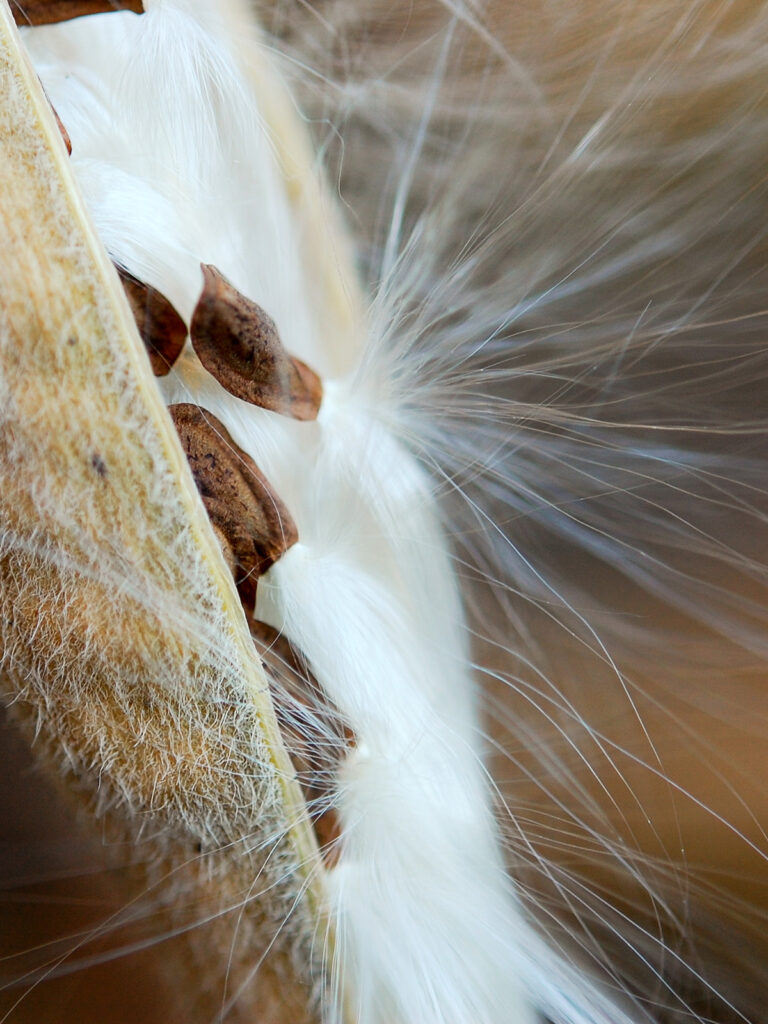
Milkweed is NOT a “weed”!
(And for that matter, what IS a “weed” anyway?? It’s pretty subjective. I’d call burning bush and other invasive plants the real “weeds”!)
Milkweed is an essential plant for monarch caterpillars and beautiful in its own right — even its seedpods!
REMEMBER: No milkweeds, no monarchs!
Here’s how to grow them, but first, here’s some information about this fascinating plant.
IMPORTANT: Be careful not to get milkweed sap in your eyes!
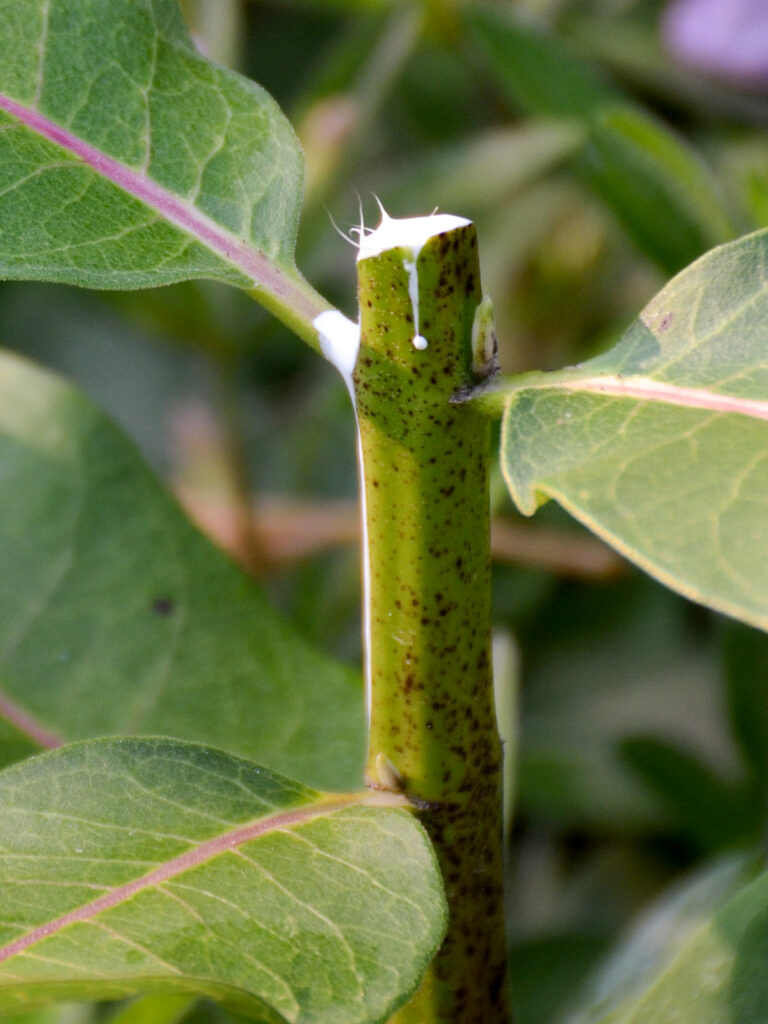
We’re grateful we had gotten our milkweeds from our HGCNY-Wild Ones native plant nurseries, not retail nurseries, where harmful pesticides have been found in the milkweeds they sell. (See Xerces info in Resources below.)
Milkweed the plant
All species of milkweed are in the genus Asclepias. Thus, Asclepias tuberosa is butterfly weed, Asclepias incarnata is swamp milkweed, and so on. (I’ve found that learning the botanic names is really useful.)
The milkweed flower’s individual florets are intriguing. It always looks like a beagle face to me!
Unlike many other flowers, milkweed flowers don’t have pollen grains. They have structures called pollinia instead.
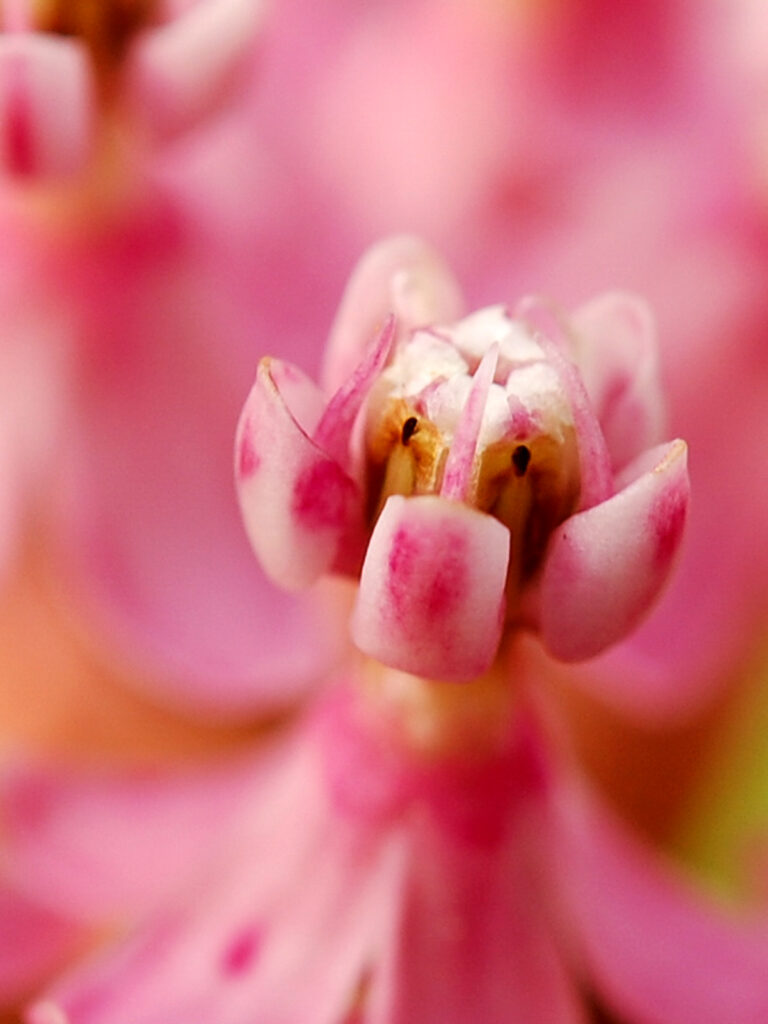
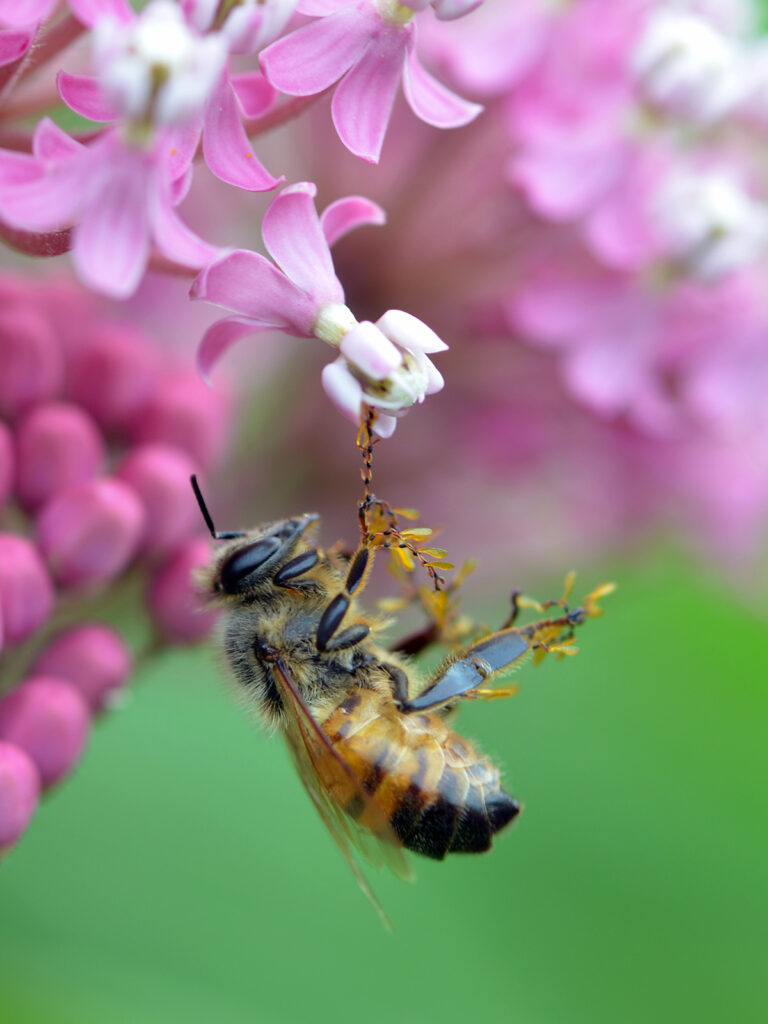
Insects (in addition to butterflies) flock to get the nectar, but bees sometimes get stuck in the flower, as this honey bee did.
In their quest for the milkweed’s abundant nectar, insects’ legs get stuck in the slit between the “hoods” of the flower. Most of them can pull away, along with the attached pollinia — which is the plant’s pollination “goal”— but some never make it or may leave a leg behind when they escape.
Milkweeds native to the Northeast
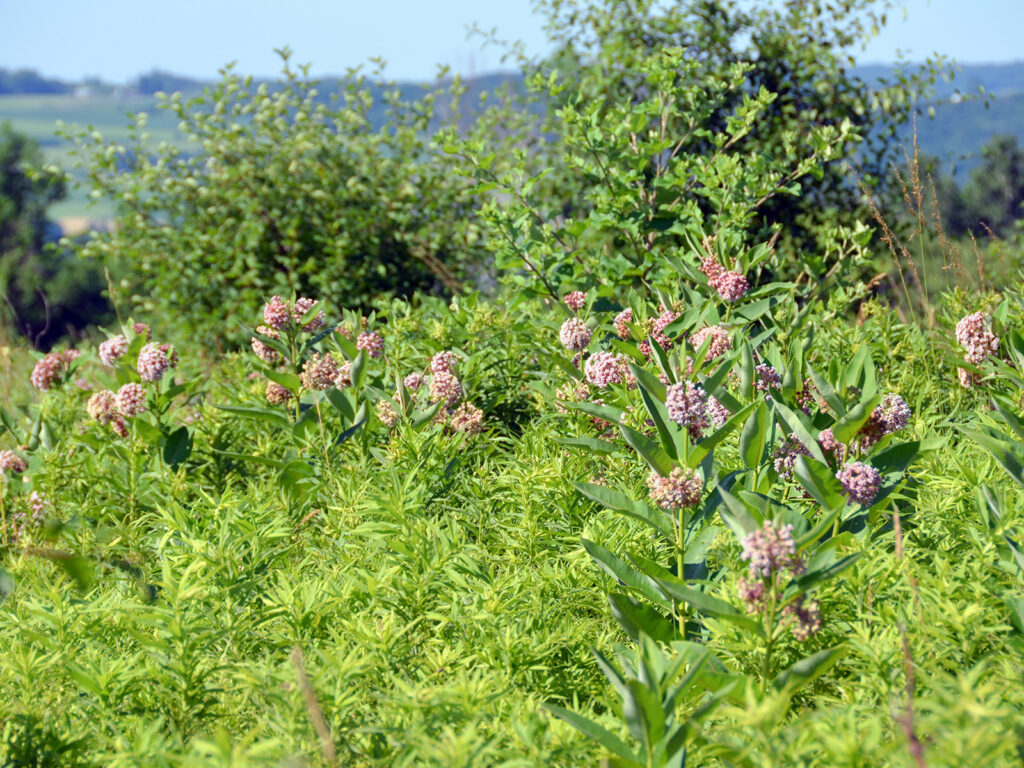
Fields full of milkweed used to be a common sight. Alas, no more.
This lakeside CNY field currently full of milkweeds is slated for someone’s vacation home.
Below are some milkweed species native to the Northeast. Other types of milkweeds are native to other regions. Some sources indicate that there are 72 milkweeds native to the US and 108 native to the continent, of which 30 (so far) have been shown to be used by monarchs as their caterpillar host plant.
Why native milkweeds? Many people grow tropical milkweed (Asclepias curassavica) and assume just because monarchs “like it” it’s a good choice. But there are lots of reasons for sticking with the natives (see the resources below for more information about this issue).
Milkweeds in CNY
Swamp milkweed (Asclepias incarnata)
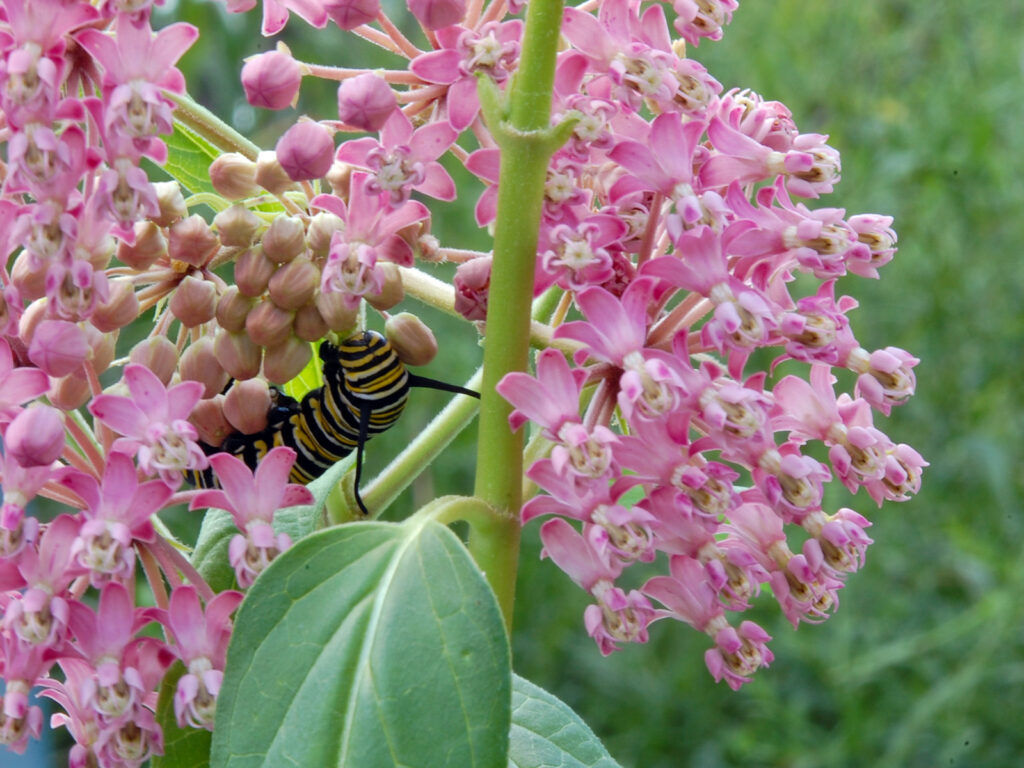
In our yard, swamp milkweed is a monarch favorite. It’s also a beautiful garden plant.
Contrary to its name, swamp milkweed doesn’t grow only in a swamp or in wet areas, at least here in CNY. (It may need more moisture in hotter climates.)
Most of ours are growing in “regular” soil, though in the past I’ve grown some in the shallow edges of our pond. We’ve grown them in sun and in part sun conditions, but they don’t thrive in deeper shade. (But note that even if they don’t get enough sun to flower, monarch caterpillars can still eat the leaves.)
Common milkweed (Asclepias syriaca)
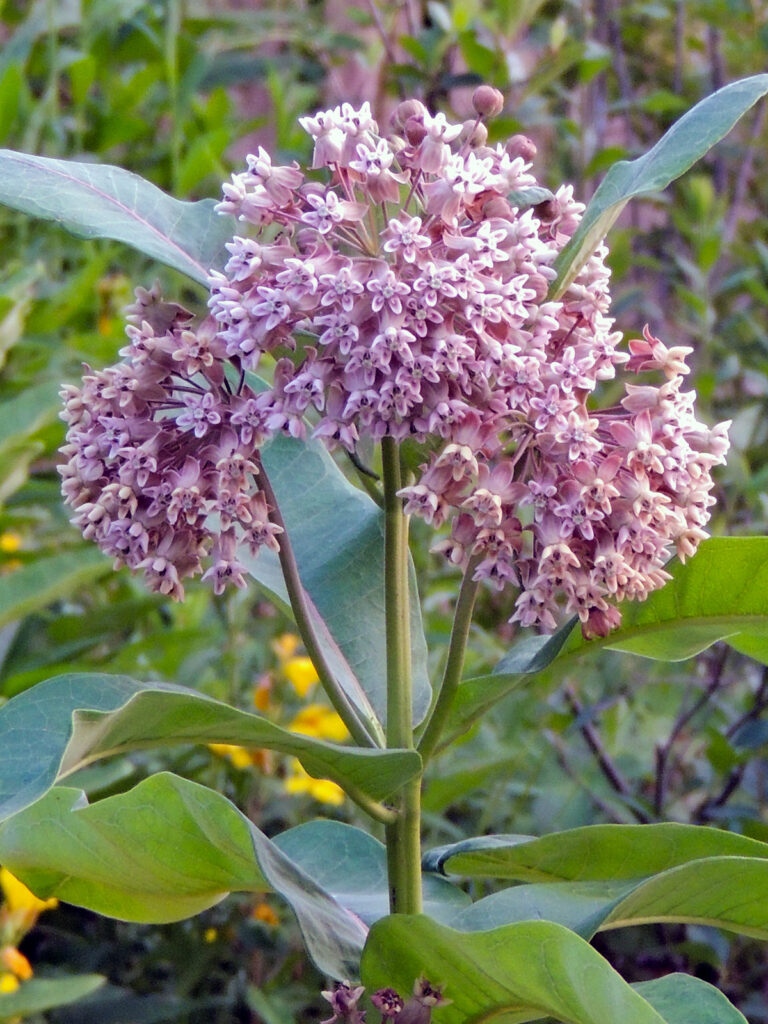
As the name indicates, common milkweed is a very commonly-seen milkweed growing in the wild.
Or at least it used to be common before people started ripping it out as a “weed” — which is the reason we all need to plant more.
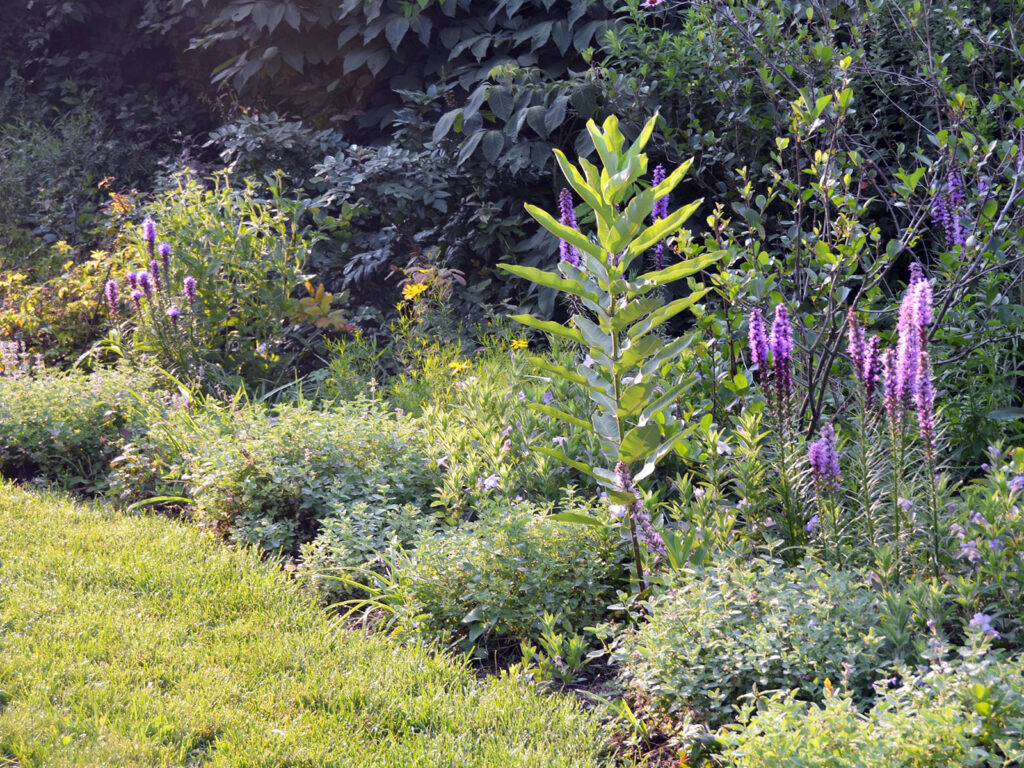
The tall plant you see here in front of our hedgerow is a common milkweed.
It was a bit too tall for this spot, BUT we simply pruned it back and it thrived.
Common milkweed is great for monarchs and one of their favorites, but some people are reluctant to plant them in a home landscape since it spreads by traveling underground.
We don’t mind this trait. Although they come up here and there, with a little management we haven’t found them to be a problem. We cut some back or simply yank out the errant stalks we don’t want. But FIRST we make sure the leaves don’t have eggs or little caterpillars on them.
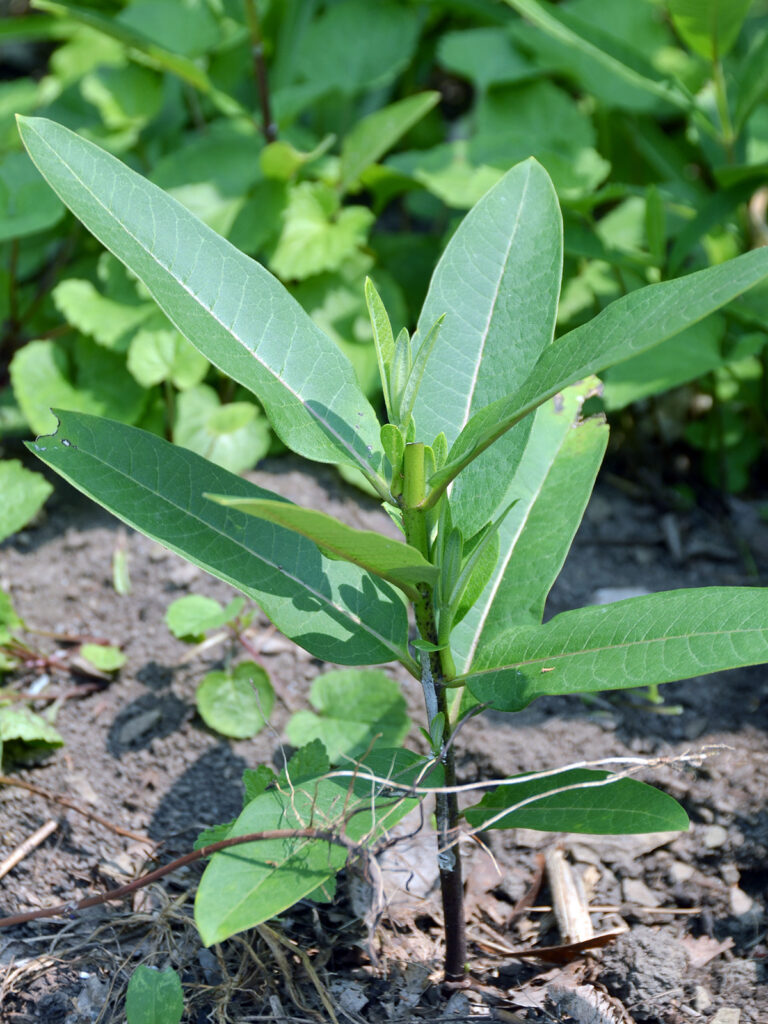
After a hard pruning (even down to ground level), it regrows tender new leaves that monarch females love, and it doesn’t reach its former height.
It’s not very particular as to soil, though we wouldn’t plant it in really dry soil. It does well in full sun, but we also grow it (albeit less vigorously) in partly shaded conditions.
Unlike our other species of milkweeds, some of which are lightly scented, common milkweed has a glorious, sweet fragrance — my favorite plant for fragrance.
Butterfly weed (Asclepias tuberosa)
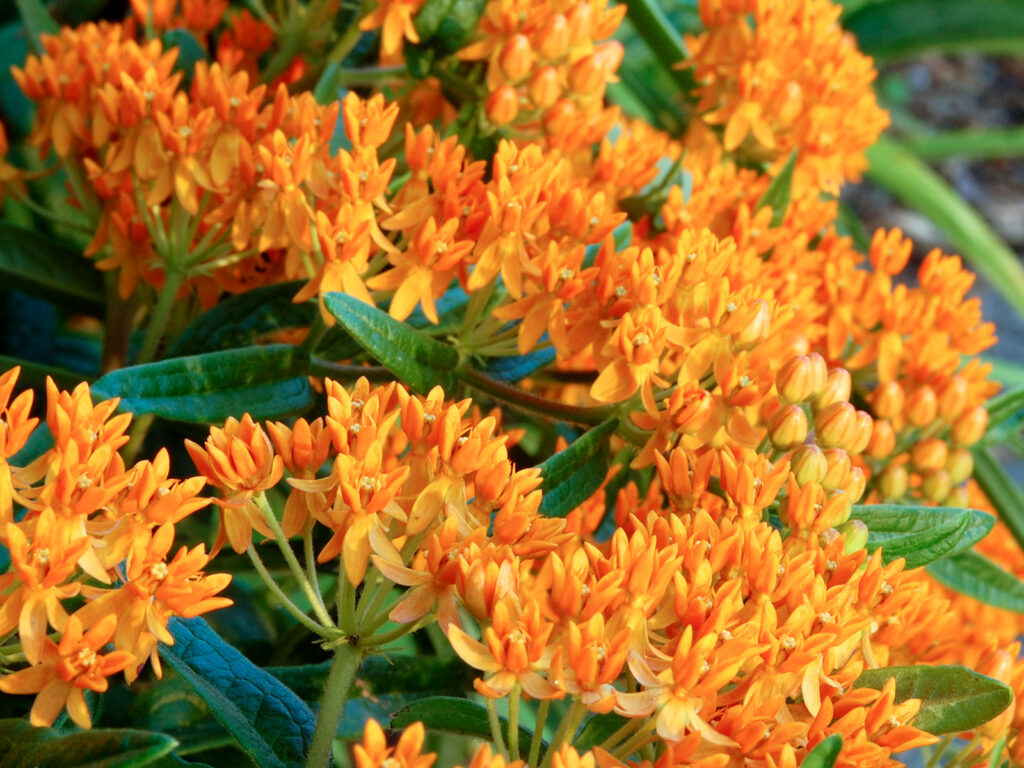
Butterfly weed is a good milkweed for dry, sunny areas with poor soil, but like the swamp milkweed, I also grow them in “regular” soil.
It does NOT like rich, moist soil, however.
[NOTE: This is butterfly weed, NOT butterfly bush (buddleia).]
The leaves are heavier and more leathery than the swamp milkweed, and I don’t find as many eggs laid on these as I do on swamp or common milkweed. I don’t rely on these for monarchs, but they do support the growth of monarch caterpillars. And besides its bright orange flowers being a real show-stopper, they’re a great nectar plant for a variety of insects, as are most milkweeds.
Other milkweeds native to our area
Poke milkweed (Asclepias exaltata)
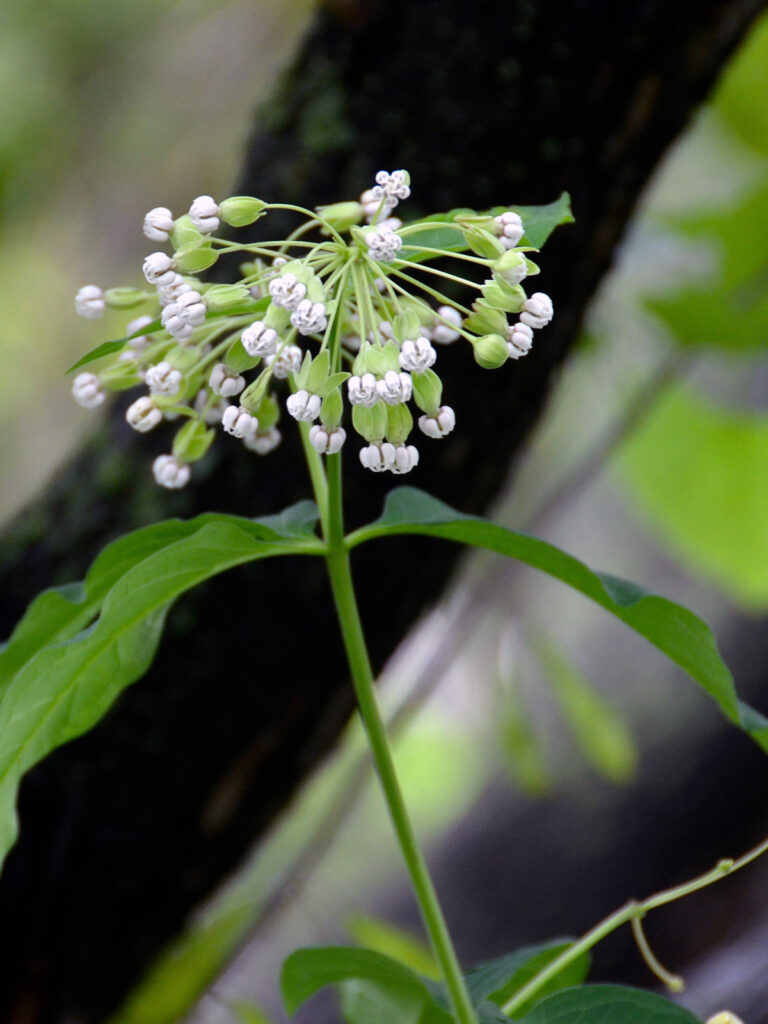
Poke milkweed is a good milkweed for shady areas. We only have a few of these, but I’ve found monarch caterpillars on them, so this species would be a good choice for a yard that has less sun than ours.
I always plan to give this plant some more room and foster a patch, but so far I haven’t done it.
Purple milkweed (Asclepias purpurascens) – NOT QUITE NATIVE
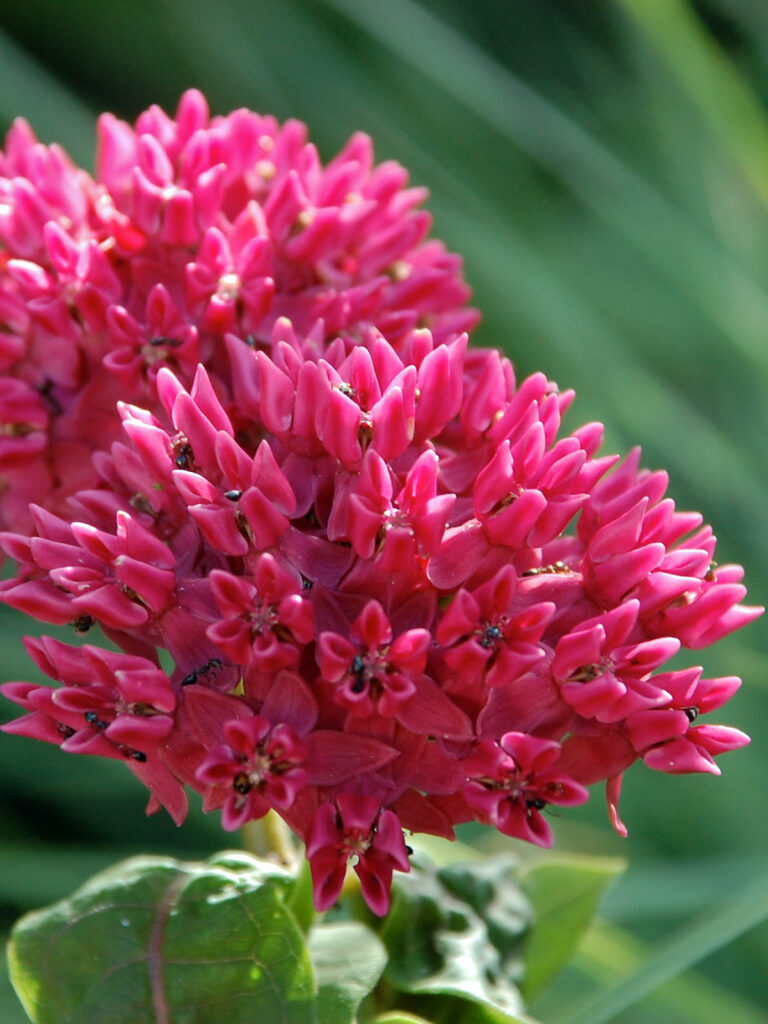
This is an absolutely gorgeous flower — such an intense, beautiful color! We only had one plant, and unfortunately, it died out. I’ve read that it needs a genetically different individual to pollinate this in order to produce seeds. I’ve rarely seen it available for sale, but I finally got one at our HGCNY plant sale.
I didn’t notice any monarchs interested in it, but I only had one individual plant of this compared to many, many swamp milkweeds.
Whorled milkweed (Asclepias verticillata)
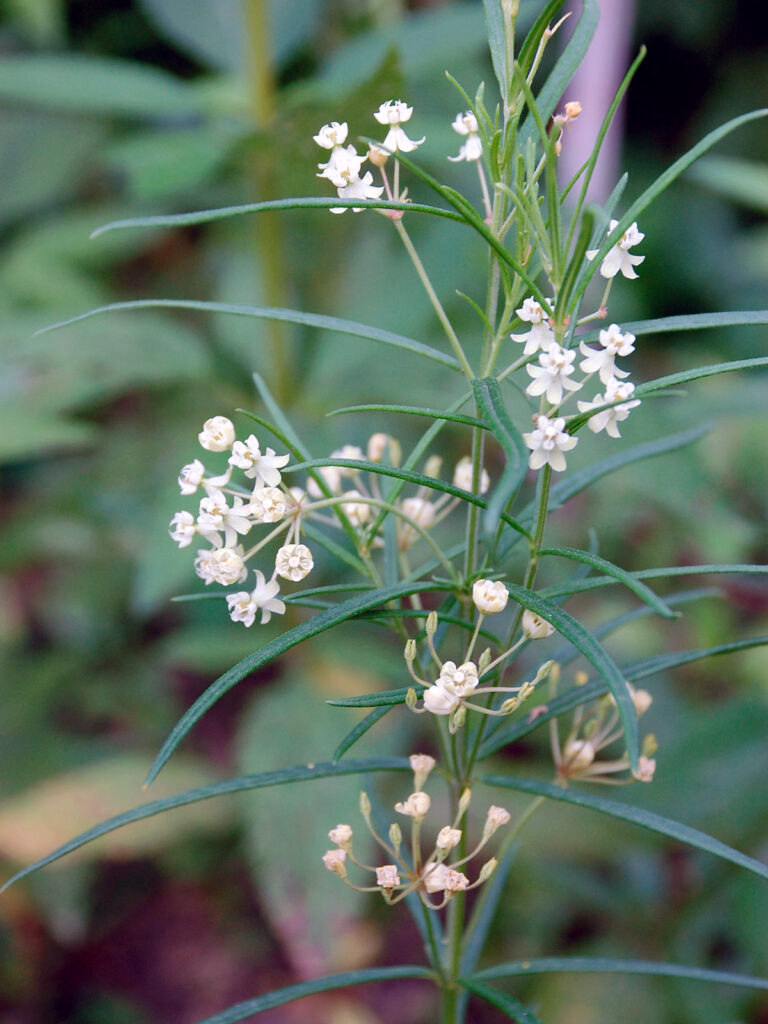
Whorled milkweed is a very slight plant, very delicate. We had a small patch of this milkweed species, but we didn’t notice any eggs on it. One caterpillar could easily eat the whole thing!
A pretty little plant, but it didn’t survive my “not-so-benign neglect” gardening habits, not being robust enough to compete with all the other plants.
If I find some more, I’ll devote a small area to it and keep it better protected.
Close doesn’t count!
Plants that look like milkweed or are related to milkweed just don’t work as food for monarch caterpillars. Here are two that grow in CNY.
Dogbane
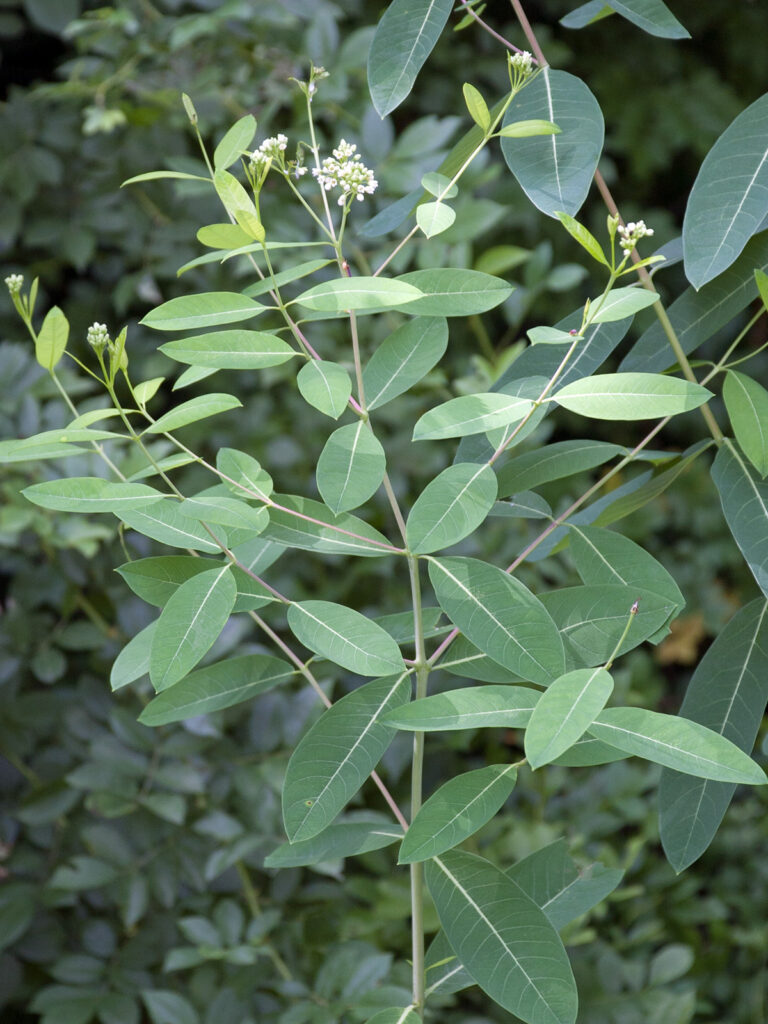
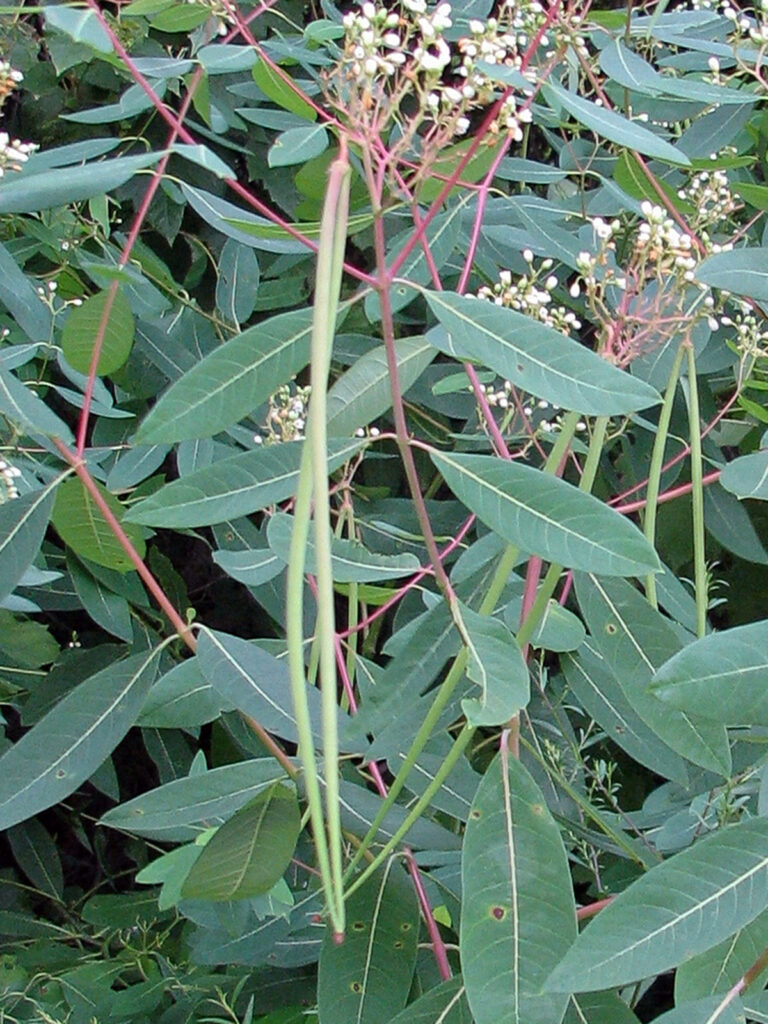
Dogbane, one of which is hemp dogbane (Apocynum cannabinum), is a native relative of milkweed, and it also has milky sap. BUT it is NOT a host plant for monarch caterpillars.
It’s easy to confuse milkweed and dogbane. I recognize this plant by its different branching structure. Dogbane does happen to be a host for other moths and butterflies, though, so it’s still a fine native plant, just not for monarchs. And monarchs do use its nectar.
Swallowwort
We’ve seen two kinds of the non-native swallowworts: black swallowwort and pale swallowwort. Swallowwort’s chemical similarity to native milkweed tricks female monarchs into laying eggs on its leaves, but monarch caterpillars cannot survive on it.
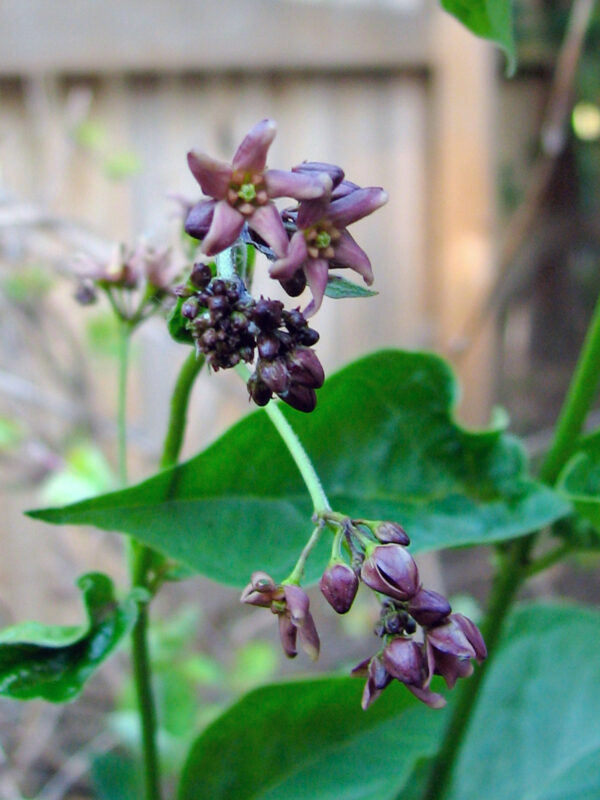
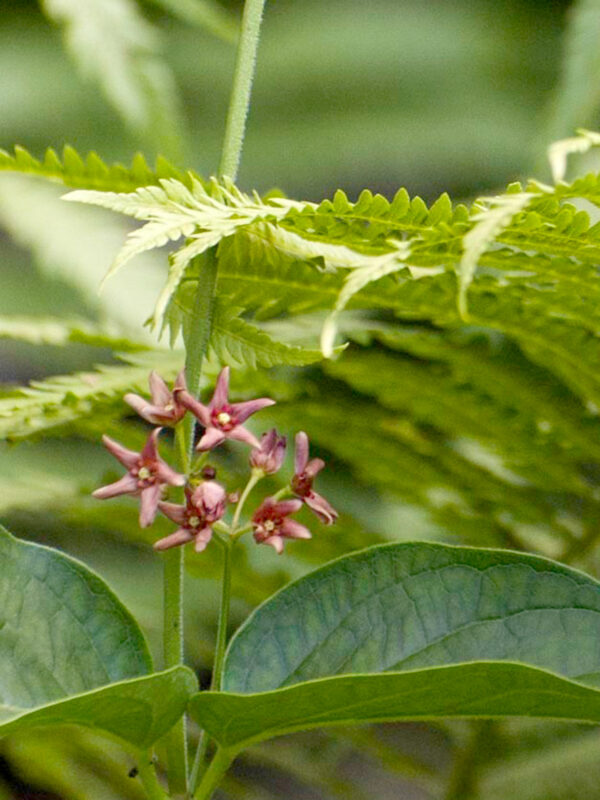
Milkweed and humans
Milkweeds have an interesting history. For example, schoolchildren collected the pods in WWII to fill life jackets, and it was even used as skin cream! (Was that safe?!?)
Companies are now experimenting with other ways to use the silk. I found one business advertising “syriaca” bed comforters. I’m sure most people don’t realize they’re buying milkweed fluff! (Note: Asclepias syriaca is the scientific name for common milkweed.)
See the Resources below for more info on how milkweed has been used.
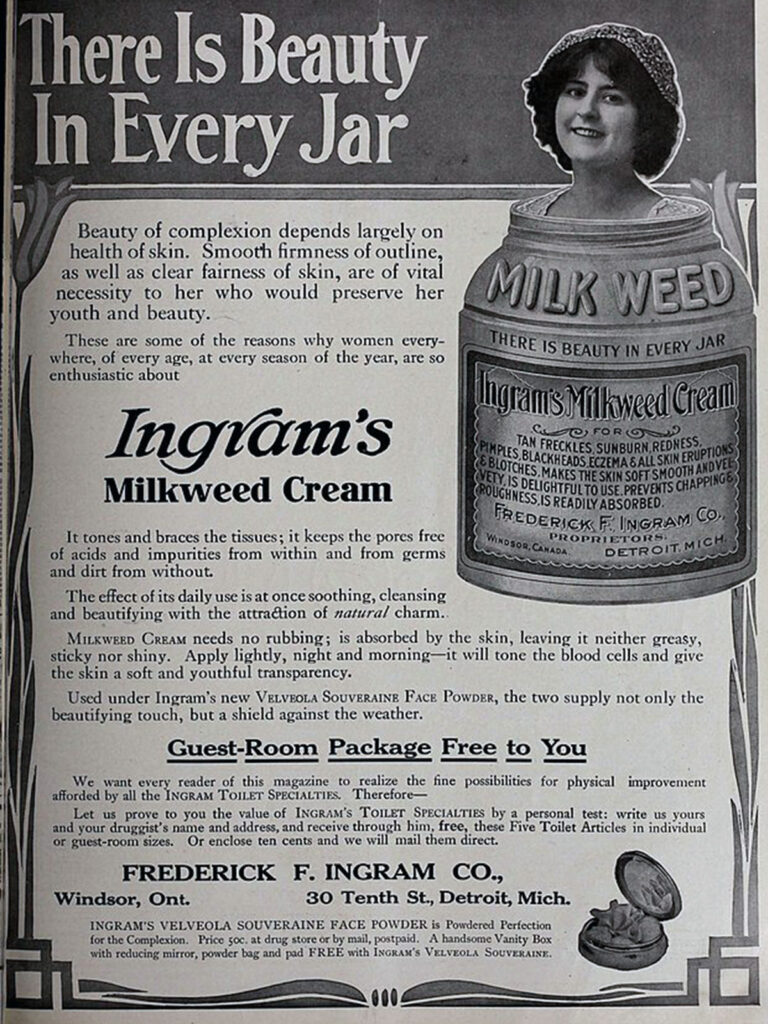
Resources
Sources of milkweeds
Monarch Watch: Milkweed Market – Lists species appropriate for each state and ecoregion and information about placing an order for a flat of milkweed plugs. On this page, there is a link to a list of vendors selling appropriate milkweed plants for each region
CAUTION: Commercially-available milkweed plants, especially from “big box” stores, are generally treated with systemic pesticides so they look good. BUT systemic pesticides, such as the neonicotinoids, can’t be washed off the leaves. They are throughout the plant, including the nectar and pollen. It’s best to purchase milkweeds from reputable local growers.
Basic info on milkweeds
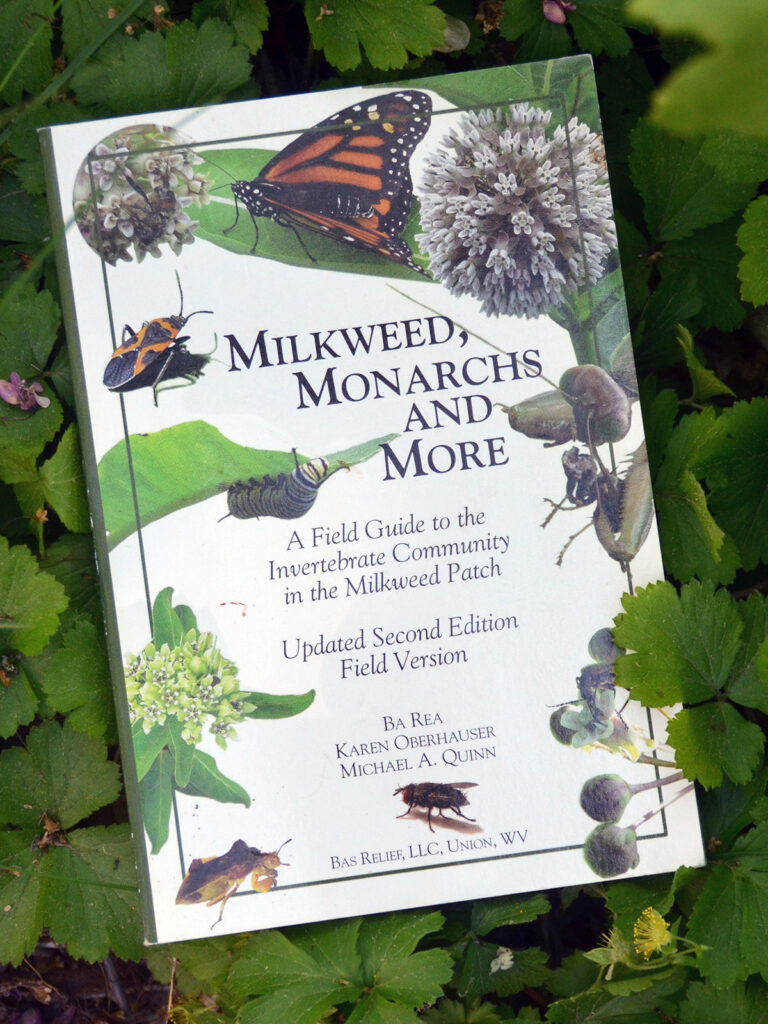
Milkweed, Monarchs and More by Ba Rae et al. is an excellent resource. It has excellent photos all of the plants and creatures I’m likely to see in our milkweed patch. I especially like the icons identifying their role in the milkweed patch relative to the milkweeds and to the monarchs. For example, it indicates whether an insect is an herbivore, a monarch predator, and so forth. I’ve found it to be very useful in figuring out what those bugs are in my milkweed areas and whether they’re something I should be concerned about with respect to monarchs.
- Monarch Joint Venture:
- Bumble bees’ role in milkweed pollination
- Fact sheet web page – a number of informative resources
- The Xerces Society:
- The Natural Web:
- Prairie Ecologist:
- Milkweed pollination: A series of fortunate events – about pollinia
- Modern Farmer:
- Microscopy-UK:
- A close-up view – Incredible close-up photos of milkweed flowers, pollinia, and pods
- Phys.org – Univ. of Calif.:
- Eye on Nature:
- Post Gazette:
- Western Illinois University:
- Research on new uses for milkweed
- Here’s a local university’s take on this new commercial milkweed industry. Will monarchs be seen as an enemy or will it result in more milkweeds being grown?
- ScienceOnline:
- VIDEO: Pollination, plants, and insects – Excellent video of bees and milkweeds’ pollinaria
- BugWhisperer:
- VIDEO: Mighty milkweeds
- YouTube:
- VIDEO: Lining mittens is a good use for the silk – But he should have removed the seeds first and planted them!
- Monarch Watch:
- VIDEO: “Milkweeds for Monarchs” series: Butterfly Milkweed
Tropical milkweed (A. curassavica)
- Xerces Society:
- Deep Look:
- VIDEO: This parasite is cramping the monarch butterfly’s style – about Oe parasite
- Smithsonian Magazine:
- Monarch Joint Venture:
- Tropical milkweed
- Oe fact sheet and tropical milkweed
- Q&A about tropical milkweed
- Va. Native Plant Society:
- Non-native milkweed: Helpful or Harmful? – Harmful!
- NY Times:
Milkweed during WWII:
- Syracuse Post-Standard:
- Recollecting Nemasket:
- Pantagraph.com:
- Wisc. Dept. of Natural Resources:
Reflections
Resurrection is less on my mind than preservation. If I can’t please orchids, I’ll welcome violets. If I can’t provide for the silvery blue butterfly, those violets will summon the common blue. To these more modest ends, the number of people planting a piece of native grassland, not the size or sophistication of the individual plantings, is what will matter, for if we don’t grow milkweeds in our gardens, we’ll have to tell our grandchildren, “We used to see monarch butterflies long ago.”
~ Sara Stein, Noah’s Garden: Restoring the Ecology of Our Own Back Yards, 1993, p. 158
